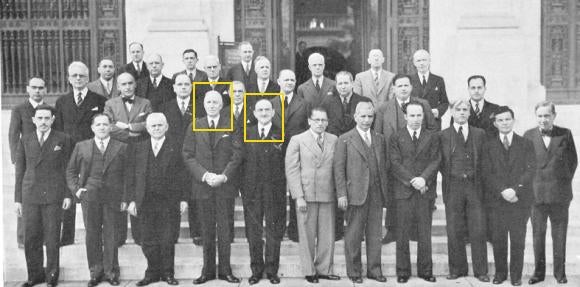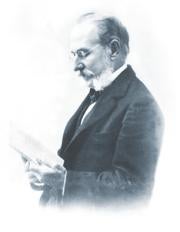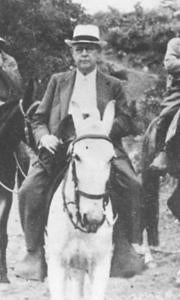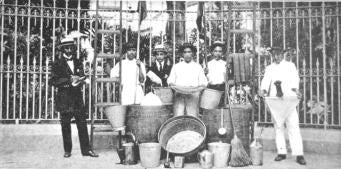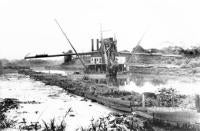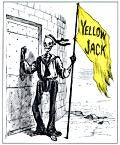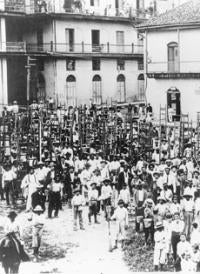This article was written by James Patrick Kiernan for the "Volume 6 No. 2 - 2002" issue of Perspectives in Health, the magazine of the Pan American Health Organization (published from 1996 to 2007).
When U.S. President Theodore Roosevelt welcomed delegates to the First General International Sanitary Convention of the American Republics in Washington, D.C., in December 1902, his thoughts may have been at least partly focused some 2,000 miles away, on the unfinished Panama Canal.
That frustrating, monumental effort-which would become President Roosevelt's pet project-was emblematic of the burgeoning commercial ties among the American republics, but also of their growing vulnerability to the spread of disease. Abandoned by French interests 14 years earlier, the canal project had fallen victim largely to yellow fever, which along with malaria had killed some 20,000 workers. Only by controlling yellow fever (it was officially eradicated in Panama in 1905) would the Roosevelt administration be able to carry the canal to completion in 1914.
Yellow fever-and the control of epidemic diseases in general-was at the top of the agenda of the 1902 International Sanitary Convention as delegates from 11 countries gathered at Washington's New Willard Hotel. Dr. Carlos Finlay, a distinguished Cuban physician, presented a paper titled "Is the mosquito the only agent through which yellow fever is transmitted?" He argued that it was, and his then-controversial theory would eventually be the key to routing the disease. But in 1902 many fellow delegates resisted his conclusions.
Still, they shared his goals. By the end of the conference, Dr. Finlay and three others had been appointed to an organizing committee charged with setting up a new international health agency for the Americas.
"It shall be the duty of the International Sanitary Bureau," declared the convention's final resolution, "to lend its best aid and experience toward the widest possible protection of the public health of each of the said Republics, in order that disease may be eliminated and that commerce between said Republics may be facilitated."
Beginning in the mid-19th century, early efforts at inter-American cooperation had been aimed almost exclusively at regulating and stimulating hemispheric trade. But by the dawn of the 20th century, it had become urgent also to curtail the spread through maritime commerce of epidemic diseases such as yellow fever, cholera, and plague.
It was these interrelated mandates that led to the creation of the International Union of American Republics and the International Sanitary Bureau, precursors, respectively, to today's Organization of American States (OAS) and Pan American Health Organization (PAHO). Established more than three decades before the United Nations and the World Health Organization (WHO), PAHO and the OAS share the distinction of being the oldest continually functioning international organizations not only in the Americas but in the world.
For the past 100 years, the OAS and PAHO have grown and evolved together from virtually unstaffed, unhoused paper entities to world-class international organizations with thousands of international civil servants on their staffs. Together they have pioneered forms of international cooperation to improve health and social conditions in the Americas, sharing credit for many important accomplishments in the fight against poverty, ignorance, and disease.
Birth of a bureau
The OAS traces its origins to the First International Conference of American States in 1889-90, in which participants from across the Americas created the juridical, if not yet institutional, foundation for what by 1910 would be known as the Pan American Union. It had as its principal objective the collection and dissemination of economic and commercial information to help promote trade among the nations of the Western Hemisphere.
The Second International Conference of American Republics, held in Mexico City in 1902, adopted a resolution to hold an international sanitary convention that same year. It was this convention that President Roosevelt greeted, and that established the International Sanitary Bureau, which by 1923 was renamed the Pan American Sanitary Bureau and would eventually become known as PAHO. The Bureau's initial raison d'être was the prompt and regular transmittal of data on sanitary conditions of seaports, maritime quarantines, and the control of communicable diseases, particularly yellow fever and bubonic plague. It started life with a seven-person committee, but no full-time staff, and a budget of just US$5,000. The Pan American Union assumed responsibility for collecting and safeguarding quotas for the Bureau paid by member states.
In hindsight, the immediate threat of yellow fever and other epidemic diseases may have been a necessary, although not entirely sufficient, condition for the early growth of inter-American cooperation in public health. Cultural factors likely also played a role. The first decade of the 20th century was one of exuberant belief in the infinite and universal possibilities of progress. In this belle époque, Pan-Americanism became a popular world view, and the early development of the Sanitary Bureau reflected that view.
The Americas' First Sanitary Conference was followed nearly every two years by a subsequent conference. The report of the Fourth Sanitary Conference (1909) declared: "The hour has arrived when the world is awakening to the need for sanitary betterment. Typhus fever, yellow fever, malaria, smallpox, plague, cholera can be eliminated." This "awakening" led to a shift in focus from sanitation of ports and regularization of maritime relations to the eradication of communicable diseases at their source.
The outbreak of World War I brought efforts at inter-American cooperation in health to a virtual halt. A Fifth Sanitary Conference was held in Santiago, Chile, in 1911, but a sixth conference, scheduled to take place in Uruguay in 1914, was cancelled. During these war years, the Bureau was so dormant that, according to its own records, "there was frequently a balance remaining at the end of the year from the U.S. quota" of just US$2,830, which reverted to the U.S. Treasury. But by the end of the decade, the sobering effects of both the Great War and the great flu epidemic of 1918-19 led the countries of the Americas to refocus their attention on the need to control communicable disease.
When the Sixth Sanitary Conference finally did meet in Montevideo, Uruguay, in 1920, delegates made a concentrated effort to reorganize and reinvigorate the Bureau to confront more seriously the problems discussed in previous conferences. Criticizing those earlier meetings (and by inference, the Sanitary Bureau), U.S. Assistant Surgeon General J.H. White argued that the objective of these efforts should be the "permanent betterment of our international sanitary relations and not as up to now a mutual exchange of reports on sanitation and demography in our respective lands with nothing done between meetings."
This sixth conference broadened the Bureau's mission to embrace the promotion of health as a whole. It would henceforth concern itself with malaria and tuberculosis campaigns, monitoring of contagious diseases, national health legislation, and scientific study of tropical diseases. The fact that yellow fever had by 1919 retreated throughout the Americas facilitated this broader, more ambitious focus.
Pan-American partnership
Both the Pan American Union and the Sanitary Bureau were fortunate in the early 1920s in the selection of the men who would direct them. Mr. Leo Rowe, an American law and political science professor who devoted most of his life to the Pan-American cause, was named the Pan American Union's director general and served in that post until his death in an automobile accident in 1946.
Dr. Hugh Cumming, a prominent U.S. expert on sanitation and immigration issues, was appointed both U.S. surgeon general and director of the Pan American Sanitary Bureau in 1920 and served as director of the Bureau until 1947. Both dedicated Pan-Americanists, Mr. Rowe and Dr. Cumming shared a close friendship based on mutual respect and common goals, and their personal closeness helped forge strong ties between the Pan American Union and the Bureau. Determined institution builders, they worked diligently and strategically to broaden the focus and responsibilities of their organizations.
Perhaps their most significant collaboration was in using the Pan American Union's structure as an institutional umbrella to support the growth and development of the smaller Bureau. This was achieved through Pan American Union meetings and other conferences dealing with the public health structure in the Americas. At the Pan American Union's behest, a new series of meetings of ministers (then called "national directors") of health was launched, eventually alternating with the sanitary conferences every two years. These meetings, which were organized by the Bureau, helped ensure that member countries' top health officials had a say in-and would more enthusiastically support-the Bureau's work.
Within this framework, the Bureau's budget expanded tenfold between 1921 and 1926, from US$5,000 to US$50,000. Its still-small staff was augmented by public health experts seconded from the U.S. Public Health Service (USPHS), which Dr. Cumming also headed as U.S. surgeon general. The Bureau's concerns continued to expand, now including a whole new range of issues, from immigration to drug addiction and venereal disease.
During the 1920s, the Bureau acquired the first of what would become a long line of "traveling representatives." Dr. John Long, auxiliary surgeon general of the USPHS (and later the Bureau's own assistant director), undertook missions for the Bureau to more than half the countries of Latin America and the Caribbean, traveling to remote areas as well as urban centers to examine health conditions and coordinate national health authorities' work with that of the Bureau. Chief among Dr. Long's concerns was controlling rats in the region's ports, as the most effective means of stopping the spread of bubonic plague. Dr. Long's work was critical to the region's success in fighting that disease.
A code for health
The Seventh Sanitary Conference, held in Havana in 1924, proved to be the pivotal inter-American meeting related to health. Its delegates drafted and adopted the Pan American Sanitary Code, the first multilateral treaty of any kind to be signed by all the American republics. Still in force today, the Sanitary Code commits signatory nations to common and cooperative efforts in public health. Most of its original provisions reflected its primary maritime and commercial nature; however, it also brought to the fore the newer issue of workers' health. Equally important, it gave the Bureau a firmer juridical foundation and formalized its duties and responsibilities, something that in later years would help protect its institutional autonomy.
When the Great Depression hit in 1929, it brought a major social crisis to Latin America, creating widespread unemployment and exacerbating income inequality. For the Pan American Sanitary Bureau, these conditions called for greater involvement in its member states' efforts to provide health and social services, particularly in the areas of maternal and child health and nutrition. Yet in 1931, the Bureau remained housed in a single office of the Pan American Union building, staffed with only six permanent technical and clerical workers, and all professional staff still on loan. Its US$50,000 budget was insufficient to meet its growing responsibilities. As Director Cumming wrote in his 1931 report: "The Bureau's expenditures have again exceeded its receipts, and its reserve funds have been drawn upon to cover this deficit."
It was during the early years of World War II that this picture finally began to change. With Europe consumed by war, but the United States not yet involved in the conflict, the influence of neighboring Latin America-its popular culture, styles, and fashions-became greater in the United States than at any time previous or since. One result was increased U.S. funding for the Pan American Sanitary Bureau, particularly in the areas of institutional development for medicine and public health, and training for health care personnel.
With funding from USPHS and the Office of Inter-American Affairs, as well as from philanthropies such as the Rockefeller Foundation and the Commonwealth Fund, the Bureau launched a series of fellowship programs for training in public health, medicine, and related sciences. From 1939 to 1943, these programs awarded more than 200 fellowships to Latin American health professionals and scientists, and during the remaining war years and immediately afterward, more than 250 annually. For the United States, these fellowships also no doubt helped to win hearts and minds in the ideological conflicts that were part of World War II.
Once the United States did enter the war, funding sources that were being mobilized for the war effort also became available for public health services and institution building. From 1935 to 1940, the Bureau's budget more than doubled from US$52,000 to US$107,000; in 1942-43, it increased to a still-modest US$113,000, but the funds the Bureau administered were three times that amount. By 1946, the Bureau had 17 in-house staff, four divisions (statistics, editorial, fiscal, library), three sections (sanitary engineering, nursing, and fellowships), and two regional offices, in Lima and Guatemala City.
Also during this period, the Tenth Sanitary Conference (1938) expanded the Bureau's mandate once again and recommended new modes of cooperation in areas including social security, training of public health physicians and personnel, and the organization and expansion of public health nursing services. When by 1939 it became clear that the Pan American Highway would become a reality, the Bureau began to look at health and sanitary conditions along its proposed route, understanding that the highway would be a significant and difficult-to-manage conduit for communicable diseases.
Toward a better bureau
When World War II ended in 1945, the Pan American Union and the Bureau found themselves at a dramatic juncture. In a collective effort to build a better world, the victorious Allies created the United Nations and its various agencies. Both the Pan American Union and the Bureau had to work out their place in this new constellation of world organizations.
Meeting in Bogotá in 1948, the member states of the Pan American Union adopted the Charter of the Organization of American States, which confirmed that the inter-American regional political organization would be cooperative with, but not subordinate to, the U.N. system.
For the Bureau, the resolution was somewhat different. The World Health Organization, created on paper in 1946 and officially launched two years later, signed an agreement with the Pan American Sanitary Bureau in 1949 establishing the latter as both WHO's regional office for the Americas and an autonomous inter-American specialized health agency. (During the 1920s and 1930s, the Bureau had served as the regional office of the Paris-based Office International d'Hygiène Publique, giving it experience with such a dual role.) The fact that the Bureau was not absorbed by WHO, but remained autonomous, was largely the result of the success of its director at the time, Dr. Fred Soper, in raising US$1.3 million for its budget-at the time more than one-third of the budget of the nascent WHO.
The five years following the war saw an increasing internationalization and "Latin-Americanization" of both the Bureau and the Pan American Union/OAS. Both grew at a rapid rate in terms of budgets and personnel. These years also saw the separation of the two organizations' fiscal management and administration. In 1947, the Bureau moved out of the Pan American Union Building, and by 1952, it had purchased its own building near Washington's Dupont Circle, using a no-interest loan from the Rockefeller and W.K. Kellogg foundations.
Whereas in 1945, the Bureau had still been a relatively modest agency staffed largely with borrowed personnel, by 1950 it was an expanding international organization with a rapidly developing permanent international professional public health staff drawn from its member states. In addition to its own budget, the Bureau administered programs for other international organizations (including WHO and UNESCO), as well as foundations (such as Rockefeller and Kellogg) and agencies of its member governments (among them Brazil's Serviço Nacional de Febre Amarela and USPHS).
But their administrative separation did not prevent continued cooperation between the OAS and the Bureau, which in 1958 was renamed the Pan American Health Organization. New challenges continued to demand joint efforts. During the 1960s, PAHO was charged with carrying out the ambitious health projects of the Alliance for Progress, while funding for those projects was channeled through the OAS's Economic and Social Council. PAHO also formed a partnership with the Inter-American Development Bank, which in 1959 became the newest member of the Inter-American System. Together, they developed a health investment policy that would lead to significant advances over the next two decades in Latin American public health.
During the politically tumultuous 1970s and the "lost decade" (economically) of the 1980s, PAHO and the OAS-along with other agencies of the Inter-American System-worked to meet both the region's growing needs and changing expectations created by a new recognition of the relationship between social conditions, public health, and development.
By the end of the 20th century, old challenges such as the spread of disease through maritime commerce had been replaced by largely new ones, including AIDS, alcohol and drug abuse, natural disasters, and environmental health. It is fitting that two organizations whose creation, growth, and development were so intertwined have combined efforts to tackle these challenges and will no doubt continue to work together to confront those that lie ahead.
Dr. James Patrick Kiernan is editor of Americas Magazine and official historian of the Organization of American States.


